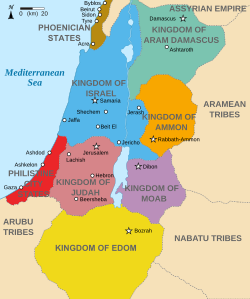Kingdom of Aram-Damascus | |||||||||
|---|---|---|---|---|---|---|---|---|---|
| c. 12th century BCE–732 BCE | |||||||||
 The region around 830 BCE, with Aram-Damascus in green | |||||||||
| Capital | Damascus | ||||||||
| Common languages | Old Aramaic | ||||||||
| Religion | Ancient Semitic religion | ||||||||
| Demonym(s) | Aramean | ||||||||
| King | |||||||||
• 885 BCE–865 BCE | Ben-Hadad I | ||||||||
• 865 BCE–842 BCE | Ben-Hadad II | ||||||||
• 842 BCE–796 BCE | Hazael | ||||||||
• 796 BCE–792 BCE | Ben-Hadad III | ||||||||
• 754 BCE–732 BCE | Rezin (last) | ||||||||
| History | |||||||||
• Established | c. 12th century BCE | ||||||||
| 732 BCE | |||||||||
| |||||||||
| Today part of | Syria Jordan Israel Lebanon | ||||||||
The Kingdom of Aram-Damascus (/ˈærəm ... / ARR-əm ...; Syriac: ܐܪܡ-ܕܪܡܣܘܩ) was an Aramean polity that existed from the late-12th century BCE until 732 BCE, and was centred around the city of Damascus in the Southern Levant.[1] Alongside various tribal lands, it was bounded in its later years by the polities of Assyria to the north, Ammon to the south, and Israel to the west.
- ^ Pitard, Wayne T. (2000). "Arameans". In David Noel Freedman; Allen C. Myers; Astrid B. Beck (eds.). Eerdmans Dictionary of the Bible. Wm. B. Eerdmans Publishing Co. p. 86.